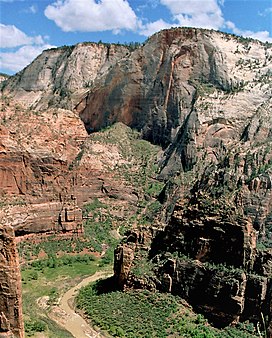| Cable Mountain | |
|---|---|
 Northwest aspect, from Angels Landing Trail Northwest aspect, from Angels Landing Trail(The Organ in lower right) | |
| Highest point | |
| Elevation | 6,940 ft (2,120 m) |
| Coordinates | 37°16′02″N 112°56′00″W / 37.2672163°N 112.9333141°W / 37.2672163; -112.9333141 |
| Geography | |
  | |
| Country | United States |
| State | Utah |
| County | Washington |
| Protected area | Zion National Park |
| Parent range | Colorado Plateau |
| Topo map | USGS Temple of Sinawava |
| Geology | |
| Rock age | Jurassic |
| Rock type | Navajo sandstone |
| Climbing | |
| Easiest route | class 1 hiking trail |
Cable Mountain is a 6,940-foot (2,120 m) elevation Navajo Sandstone summit located in Zion National Park, in Washington County of southwest Utah, United States. Towering 2,600 feet (790 meters) above the floor of Zion Canyon at the Big Bend area, Cable Mountain is situated immediately northeast of The Great White Throne, separated by the chasm of Hidden Canyon. It is set on the east side of the North Fork Virgin River which drains precipitation runoff from this mountain. Its neighbors include Angels Landing, Cathedral Mountain, The Organ, and Observation Point. This mountain's name was officially adopted in 1934 by the U.S. Board on Geographic Names. It is so named in association with the draw-works which used cables to lower timber from the top of the plateau down to the valley bottom from 1901 through 1927. Wood to construct the Zion Lodge came down the cable works. A 7.4-mile trail, much of it an old wagon road, leads to the views from the top.
Climate
Spring and fall are the most favorable seasons to visit Cable Mountain. According to the Köppen climate classification system, it is located in a Cold semi-arid climate zone, which is defined by the coldest month having an average mean temperature below 32 °F (0 °C), and at least 50% of the total annual precipitation being received during the spring and summer. This desert climate receives less than 10 inches (250 millimeters) of annual rainfall, and snowfall is generally light during the winter.
Gallery
-

-

-
 Cable Mountain from northeast
Cable Mountain from northeast
-
 Cable Mountain (red cliff), The Great White Throne (right), from Observation Point
Cable Mountain (red cliff), The Great White Throne (right), from Observation Point
-
 Cable Mountain centered
Cable Mountain centered
-
 Observation Point left, Cable Mountain centered, The Great White Throne right.
Observation Point left, Cable Mountain centered, The Great White Throne right.
Viewed from Angels Landing -
 Cable Mountain Draw Works relics
Cable Mountain Draw Works relics
-
 Cable Mountain Draw Works headframe and machinery
Cable Mountain Draw Works headframe and machinery
-
 Draw works at the top
Draw works at the top
-

Cable Mountain Draw Works
The Cable Mountain Draw Works was built by David Flanigan beginning in 1901, although he had first proposed the system as a teenager in 1885. From 1904, timber was harvested from the heights above the valley and moved from Cable Mountain down to the draw works in the valley, a vertical distance of 2,000 feet (610 m). The system fulfilled an 1863 prophecy made by Brigham Young that timber would descend from the cliffs "like a hawk flying." Before the draw works were constructed, the timber on Cable Mountain was obtained only by a ten-day round trip. Flanigan sold the operation in 1906 to Alfred Stout and O.D. Gifford of Springdale, who operated it as the Cable Mountain Timber Works. The draw works were destroyed by lightning and rebuilt in 1911. Intermittent operation continued until 1926 when the system was abandoned. The cables were removed in 1930. It is the oldest pre-park structure in Zion. The site was individually listed on the National Register of Historic Places on May 24, 1978, reference number 78000281. The chief remaining structure is a wood headframe on Cable Mountain. The structures at the bottom of the cables consisted of snubbing posts to separate the cables. Nothing remains of the lower end of the draw works.
See also
References
- "Cable Mountain Viewpoint, Utah". Peakbagger.com.
- ^ U.S. Geological Survey Geographic Names Information System: Cable Mountain
- Cable Mountain Draw Works, National Park Service
- Greg Witt, 50 Best Short Hikes Utah's National Parks, 2nd Edition, Wilderness Press, 2014, page 212.
- "Zion National Park, Utah, USA - Monthly weather forecast and Climate data". Weather Atlas. Archived from the original on January 27, 2019. Retrieved August 31, 2020.
- Parkinson, Charles R. (September 1977) . "National Register of Historic Places Inventory - Nomination Form: Cable Mountain Draw Works". National Park Service. Retrieved September 4, 2009.
External links
- Zion National Park National Park Service
- Weather forecast: Cable Mountain
- Cable Mountain Draw Works: National Park Service
- August 2019 rock avalanche investigation: ugspub.nr.utah.gov